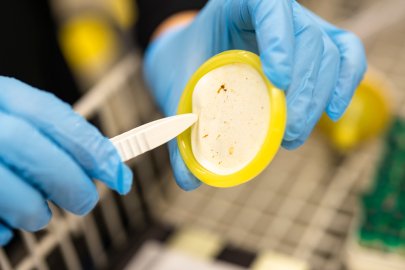A new, nontoxic antibiofouling coating reduced the adhesion of algae, mussels, and larva on flat surfaces, rope, nets, and other materials used in the hydropower and marine energy sectors.
Water Power Technologies Office
March 14, 2024Hydropower Program
Environmental and Hydrologic Systems Science
Project Name: Superhydrophobic Lubricant-Infused Composite: Surface Coatings to Prevent Biofouling
Project Team: Pacific Northwest National Laboratory
Lead Recipient Location: Richland, Washington

Researchers from Pacific Northwest National Laboratory (PNNL) formulated a nontoxic superhydrophobic, lubricant-infused composite (SLIC™) designed to prevent biofouling—the accumulation of plants, animals, and microorganisms on wet surfaces—that can be used on both flat and flexible surfaces (such as ropes, nets, and buoy lines). The antibiofouling technology has enormous implications across both the marine and hydropower sectors, where equipment frequently degrades when in contact with organisms found in water.
Both hydropower and marine energy infrastructure operate in an aggressive and dynamic environment, leaving dam structures and marine energy equipment vulnerable to various forms of biofouling, such as algae, plankton, and invasive zebra and quagga mussels. Equipment and components such as penstocks, trash racks, and heat exchangers are common collection points for mussels, making them laborious to clean. Currently, the effects of biofouling are mitigated by coating surfaces with specialized paints. However, these existing coatings often break down and may put toxic substances into the water.
SLIC™-coated samples and a competitor's traditional antifouling coating were deployed near the inlet of Parker Dam by Dr. Allen Skaja of the Bureau of Reclamation for six months.
PNNL has been developing new, high-performance antifouling coatings since 2019. SLIC combines a spongelike porous microstructure and a canola-oil-based lubricant that greases the surface and can be applied like any other paint. It offers multiple forms of protection to prevent the adhesion of biological material.
The team recently received data on SLIC from an extended exposure test at the Bureau of Reclamation's Parker Dam test site in California, marine field test sites in the Puget Sound, and a lab-based test, all of which indicated positive performance under multiple conditions.
The SLIC team is now focused on testing the coating on larger items, continuing the advancement of this technology from flat to flexible surfaces, and scaling up production for eventual commercialization. In 2024, one of PNNL's commercial partners will manufacture prototype batches of SLIC for the first time.
-
 Pacific Northwest National Laboratory supported the 25th annual Salmon Summit, an educational event in eastern Washington designed in part to inspire the next generation of hydropower researchers, diverse STEM professionals, and a science-aware community.
Pacific Northwest National Laboratory supported the 25th annual Salmon Summit, an educational event in eastern Washington designed in part to inspire the next generation of hydropower researchers, diverse STEM professionals, and a science-aware community. -
 National laboratory researchers examined and published a report on how climate change may affect water availability for federal hydropower marketing and generation and its impact on future energy demand.
National laboratory researchers examined and published a report on how climate change may affect water availability for federal hydropower marketing and generation and its impact on future energy demand. -
 Researchers used a variety of sampling techniques to consistently and accurately measure methane and carbon emissions from six hydropower reservoirs
Researchers used a variety of sampling techniques to consistently and accurately measure methane and carbon emissions from six hydropower reservoirs -
 A biodegradable and nontoxic hydropower oil has gone through several rounds of testing as its developer aims to ramp up production to achieve commercialization in the next few years.
A biodegradable and nontoxic hydropower oil has gone through several rounds of testing as its developer aims to ramp up production to achieve commercialization in the next few years. -
 Oak Ridge National Laboratory improved upon fish species detection and counting using environmental DNA and RNA sequencing, potentially saving time, decreasing costs, and reducing environmental impacts on aquatic species and habitats.
Oak Ridge National Laboratory improved upon fish species detection and counting using environmental DNA and RNA sequencing, potentially saving time, decreasing costs, and reducing environmental impacts on aquatic species and habitats. -
 A new, nontoxic antibiofouling coating reduced the adhesion of algae, mussels, and larva on flat surfaces, rope, nets, and other materials used in the hydropower and marine energy sectors.
A new, nontoxic antibiofouling coating reduced the adhesion of algae, mussels, and larva on flat surfaces, rope, nets, and other materials used in the hydropower and marine energy sectors.
WPTO's hydropower e-newsletter features news on R&D and applied science to advance sustainable hydropower and pumped-storage technologies.
The WPTO e-newsletter brings funding opportunities, events, publications, & hydropower and marine energy updates directly to your inbox.


